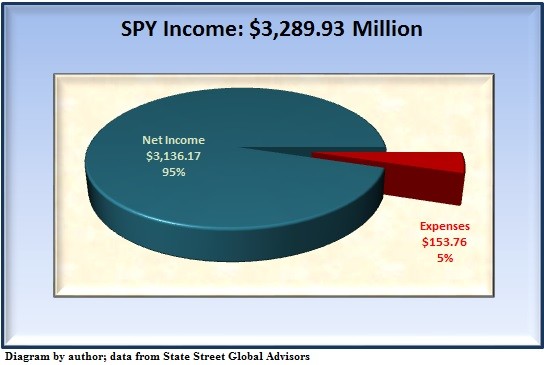ETFs v Mutual Funds Similarities and Differences Vanguard S&P 500 ETF (NYSEARCA VOO)
Post on: 5 Август, 2015 No Comment

When categorizing various investment vehicles, most investors tend to think of mutual funds and ETFs as polar opposites. Mutual funds are associated with active management, with a team of analysts and managers seeking to generate alpha by identifying undervalued securities from a relevant universe of stocks and bonds. ETFs, on the other hand, connote a passive investment strategy, products that seek to replicate the performance of a certain benchmark instead of seeking to beat it. For those who believe that active management (or at least certain active managers) add value, mutual funds may be preferred. For those who believe that it is impossible to consistently outperform markets, the lower-expense beta offered by ETFs are more attractive.
While these classifications of mutual funds and ETFs are generally truemost mutual funds are actively-managed, and more expensive than passively-indexed ETFsthey certainly arent hard and fast rules of investing. There are, of course, actively-managed ETFs that utilize quantitative analytical strategies and manager expertise to select individual holdings, much like most actively-managed mutual funds. And there are mutual funds that seek to passively replicate an index, exhibiting characteristics similar to traditional ETFs. In reality, the true division is not between ETFs and mutual funds, but between active and passive. ETFs and mutual funds fall into both sides of that division.
ETFs vs. Index Funds: Similarities and Differences
Index mutual funds and passive ETFs are similar in a number of key ways. Most significantly, both seek to replicate the performance of underlying index. Although ETFs receive the bulk of the credit for the surge in popularity of indexing as an investment strategy, index mutual funds started the movement long before the first ETFs came to market. The Vanguard 500 Index Fund (VFINX), launched in 1976, is designed to track the return of the S&P 500, making it similar to the three ETFs that also seek to replicate the S&P 500. The recently-launched Vanguard S&P 500 ETF (NYSEARCA:VOO ) is actually a separate share class of the S&P 500 index mutual fund, which has total assets of more than $90 billion.
Because they seek not to generate alpha but to capture beta, index mutual funds are also similar to most ETFs in that they offer potential tax advantages resulting from lower turnover of underlying holdings. It also allows index mutual funds to charge low expense ratios that most investors associate with ETFs. The general assumption is often that all mutual funds maintain expense ratios significantly higher than ETFs. While thats generally true when comparing passive ETFs with actively-managed mutual fundsthe industry average for mutual funds is somewhere in the neighborhood of 1.4%it isnt universally true. VFINX, for example, charges just 0.18%; while thats three times the charge for VOO, its lower than most of the ETF universe. And its significantly lower than the expense ratios charged by some actively-managed ETFs; the Dent Tactical ETF (NASDAQ:DENT ), for example, offers a net expense ratio of 1.56%.
The biggest difference between these two products is the frequency with which they are priced and traded. Index mutual funds are, after all, mutual funds, and as such they are priced once a day after markets close. ETFsincluding both active and passive ETFsare priced throughout the day, and can be bought or sold whenever the markets are open. Index mutual funds are priced based on the NAV of the underlying securities, whereas the price of an ETF depends on supply and demand for the security. Although the arbitrage mechanisms in place prevent ETF prices from deviating too significantly from the NAV, it is not uncommon for these securities to trade at a slight premium or discount. So in exchange for the flexibility to trade throughout the day, investors who utilize ETFs may incur a bid-ask spread to establish or close out a position.
Which To Use?
While index mutual funds and ETFs are similar in many ways, there are still some definite advantages to utilizing ETFs. The ability to trade ETFs at any time throughout the dayinstead of having to wait until markets close to redeem at NAVcan be very valuable, especially in volatile environments. And while index mutual funds feature significantly lower costs than their actively-managed counterparts. The comparison between the mutual fund and ETF share classes of the Vanguard 500 Fund illustrate this quite well; as mentioned previously, VFINX charges 0.18%, while VOO charges just six basis points.
The primary advantages of index mutual funds, including the security of being able to execute buy and sell orders at the NAV, can be significant. Countless ETF investors have put themselves in a hole by buying at a big premium or selling at a big discount. But for those who know what theyre doing, the uncertainty associated with trading ETFs can generally be mitigated.
Disclosure: No positions at time of writing.
Disclaimer: ETF Database is not an investment advisor, and any content published by ETF Database does not constitute individual investment advice. The opinions offered herein are not personalized recommendations to buy, sell or hold securities. From time to time, issuers of exchange-traded products mentioned herein may place paid advertisements with ETF Database. All content on ETF Database is produced independently of any advertising relationships.
- Explore Key Market ETF Performance














